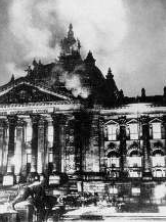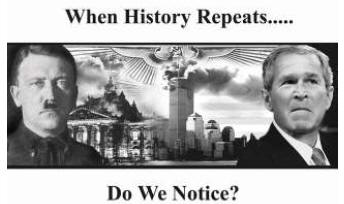 FalseFlag Operations
FalseFlag Operations
Adolf Hitler burned his own Reichstag building in 1933 to blame on his
political enemies.
He would later declare that,
“Terrorism is the best
political weapon for nothing drives people harder than a fear of sudden
death.”
Hitler’s Nazi Reich Marshall and Luftwaffe Chief
Hermann Goering is
quoted as saying,
“Naturally, the
common people don't want war … But, after all, it is the leaders of the
country who determine the policy and it is always a simple matter to drag
the people along, whether it is a democracy or a fascist dictatorship or a
Parliament or a Communist dictatorship.
Voice or no voice, the people can
always be brought to the bidding of the leaders. That is easy. All you have
to do is tell them they are being attacked and denounce the pacifists for
lack of patriotism and exposing the country to danger. It works the same way
in any country.”
FalseFlags are covert operations usually conducted by governments or
corporations which are made to appear as though performed by another entity.
For instance when Hitler burned his own Reichstag to blame on the
communists, or when the USS Maine was blownup to blame on Cuba/Spain.
FalseFlags are used disturbingly often and effectively through the
implementation of the Hegelian Dialectic, which will be explained in the
next section.
“The whole aim of practical politics is to keep the populace alarmed and
hence clamorous to be led to safety, by menacing it with an endless series
of hobgoblins, all of them imaginary.”
H.L. Mencken

“There is no excuse at this stage of American development for a
posture of political innocence, including an unquestioning acceptance of the
good faith of our government. After all, there has been a long history of
manipulated public beliefs, especially in matters of war and peace.
Historians are in increasing agreement that the facts were manipulated,
(1)
in the explosion of the USS Maine to justify the start of the
Spanish-American War (1898),
(2) with respect to the Japanese attack on Pearl
Harbor to justify the previously unpopular entry into World War II.
(3) in the Gulf of Tonkin incident of 1964, used by the White House to
justify the dramatic extension of the Vietnam War to North Vietnam, and,
most recently,
(4) to portray Iraq as harboring a menacing arsenal of
weaponry of mass destruction, in order to justify recourse to war in
defiance of international law and the United Nations.”
Richard Falk, Forward – “The New Pearl Harbor”
Back to Contents
 FalseFlag Operations
FalseFlag Operations
